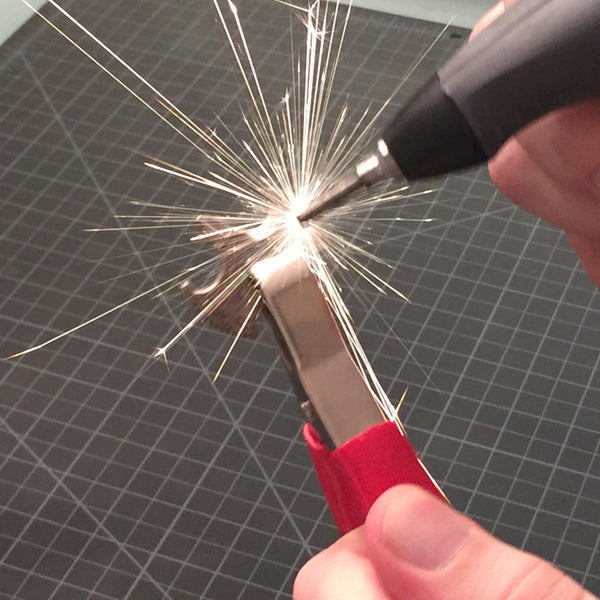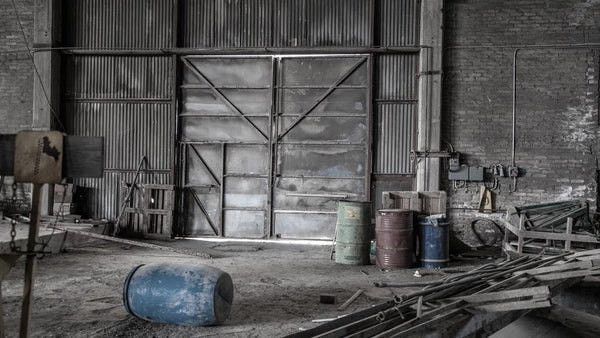10 CONCEALED CARRY DEFENSIVE TOOLS YOU CAN TAKE ANYWHERE (EVEN PLANES) FOR ABOUT $40 TOTAL

.: LEGAL DISCLAIMER :.
.: THE MINDSET :.
Why be armed?
If you are a concealed carrier, you already know the answer to this. Think of it this way: being armed expands your capability to defend yourself and others, particularly if you are in some way impeded or impaired. Being armed either levels the playing field or it gives you an advantage, which is why humans have thumbs and create tools, right?
Do you really need to be armed everywhere?
If there is a potential to need to defend myself and others, I need to have the most appropriate tools available to provide a tactical advantage. In the wilds of Alaska, that may be a large caliber rifle to defend against grizzlies. If it’s a convenience store after dusk in the rough part of town, that may be a compact pistol to defend against armed robbers.
No guns at the dinner table
Law-abiding citizens know that you can’t always have the most appropriate tools with you when you may need them. Schools, workplaces, privately-owned businesses, courthouses, military facilities and airports all have rules against carrying certain types of weapons. Some of these rules bear the weight of law, and others are policies. Some places have technology or tactics to prevent the carrying of weapons – like metal detectors, trained dogs or pat-downs – and others rely on the honor system. Some countries - UK, Europe, Asia - have different interpretations of what can be considered a weapon, so be sure to research before you pack.
A weapon is just a tool
There are at least a dozen ways to open a bottle without a bottle opener. YouTube it: lighters, countertops, spoons and belt buckles can all be used for the task. Are they as easy as using a bottle opener? Nope. But they get the job done.
Weapons are just as much tools as bottle openers, hammers and drills. When the right tool for the job is unavailable, sometimes you need to get creative and use a less effective but more available piece of equipment. A tool in the hand is worth two in a toolbox at home.
Defensive tools carried in non-permissive environments cannot only be weapons
If you are prevented from carrying weapons in a place, then it stands to reason that you can’t carry anything that will be perceived as a weapon in that place. Everything on your person needs to have a legitimate, non-weapon reason for being. Even pro baseball players who make their living with a baseball bat don’t walk down the street with a bat in their hand… let alone walk into a courtroom with one. It’s not much of a leap to go from seeing a bat as sports equipment and seeing it as a weapon.
Defensive tools in non-permissive environments need to be almost unthinkable as being a weapon, or at least unlikely. To achieve that goal, the tools need to be perfectly effective at whatever legitimate, non-weapon functions they have, and you need to have an equally legitimate reason for carrying them.
It’s only worth carrying if it makes you more effective
Could you hit someone with a hardcover edition of War and Peace? Sure. Would it hurt? Probably. Is it more effective than hitting them with your elbow? Probably not, and it’s certainly more inconvenient to carry around a thousand page novel than your elbows.
If you are going to go through the trouble of carrying defensive tools in a non-permissive environment – even if the risk of being confronted about them is minimal – that tool has to make you decidedly more effective than you are empty handed. Short of our teeth and (maybe) our fingernails, there isn’t a part of the human body that is designed to cut things, so having a tool that can cut things will make you at least that much more effective than empty-handed, but edged tools are not a magic cure-all.
Even if commercial air travel is relatively safe, what about when you get into a cab with just your carry-on at the other end of your flight? You emerge from the relatively weapons-free zone of an airport and now find yourself in the back of a cab facing a blade or a firearm. Good training aside, your tools need to keep pace with what is facing you, or you might as well just start throwing elbows and knees.
Why don’t you call these “improvised” weapons?
The bar fight starts and Scruffy the biker gets tossed head-first across the pool table. When he stands up, a pool cue catches his attention. He picks it up and swings it at the next guy to throw a punch at him. That’s an improvised weapon, and it’s improvised because he found it when he needed it… he didn’t bring it with him.
I don’t think any tool you bring with you can really be considered improvised. If you carry a newspaper around knowing that you could roll it up and use it as a weapon, that’s not much of an improvisation… that’s a plan.
You could cut someone with a broken piece of glass (improvised weapon), but you wouldn’t carry a shard of glass around in your pocket (that would make it a tool… and a dumb tool, at that). You find improvised weapons, but you bring tools.
.: THE TOOLS :.
As appealing as it may be to have a whole arsenal of defensive tools at the ready wherever you are, that will only lead to confusion if you need to use one of them immediately and under duress. It’s called Hick’s Law: the more choices you have, the slower you are to react.
Review all the options presented in this report, but focus on whatever few tools are the most appealing, effective, consistent with your training and/or natural to you. It doesn’t work if it doesn’t work for you.
If you carry a flashlight with you everywhere you go, that can be a good tool. But if it has one of those “defensive bezels” that look like killer robot teeth, don’t expect to be allowed to bring it on a plane. This report focuses on lesser known tools that can augment the things you probably already carry.
Note about links: Some of the links in this report are affiliate links to purchase recommended items. Using these links does not change what you pay to the vendors, but it credits us with a small affiliate commission if you make a purchase, to maintain operations of this site. It’s hosting (and if we’re lucky) beer money, and it doesn’t cost you a dime.
Defensive Tool #1: Coins

Coins are a versatile defensive tool.
- Constant access – You may need to empty them from your pocket while going through a metal detector, but you can bring them anywhere around the globe without suspicion.
- Use them to cause an involuntary flinch response – Toss a handful at an adversary to help you close or create distance by causing an involuntary flinch response, or create an opening for a strike. Not painful like pepper spray, but capable of causing a momentarily similar reaction.
- Use them as an impact weapon – while a roll of quarters may be conspicuous, a handful of coins adds mass to your fist as a fist load. A bunch of coins in a small coin purse or wallet pouch makes a handy sap.
Tool type: Distraction device; Impact weapon: fist-load; Projectile weapon: hand-thrown
How to carry: pocket or coin purse, or in your hand when on orange alert
Who can get away with carrying it: Anyone, anywhere
Where to get them: Your pocket, sofa cushions, parking lots, take-a-penny-leave-a-penny trays in convenience stores
Cost: 4 quarters, 5 dimes, 2 nickels and 2 pennies = $1.62 (your math may vary)
Defensive Tool #2: Carabiners

Carabiners first came into use as keychains by everyone from carpenters to students in the early 2000s. Today, they’re as commonplace as… well… keychains.
An 18-24” lanyard attached to a carbiner with keys (and/or an ID card) is de rigeur at college campuses, and acts as a less mean-looking version of a metal chain connecting keys or a wallet to a belt loop. If you hook your keys to a carabiner, you can carry it anywhere. Word of caution: do NOT wear them around your neck unless there is a breakaway connector on the lanyard.
Put your index finger through the loop and you have a powerful single-finger knuckleduster (i.e. “brass” knuckle). We prefer real carabiners that are used as climbing gear since they are made of strong aluminum and can take – and give – a beating. On a lanyard, you could always use it as a flail, but unless you’re a nunchuku master, it’s best used as a punching aid.
- Tool type: Impact weapon: Knuckleduster, fist-load, weighted end on lanyard
- How to carry it: As a keychain
- Who can get away with carrying it: anyone carrying keys
- Where to get it: hardware stores, gas stations and souvenir shops all tend to carry them, but they are not as robust as real carabiners used as climbing gear from outdoor shops. The Metolius FS Mini Carabiner is hands-down our favorite and one of the smallest but strongest on the market, and available in many colors. Get one here.
- Cost: About $6
Defensive Tool #3: Sharpened Objects – Cut-corner hotel card or filed keys

If you are looking to carry a covert sharpened tool, it will need to be something that is common. Put them together, and you get some potential creative combinations.
We have cut and sharpened notches into credit cards, hotel cards and store gift cards, and while they are not very durable or razor sharp, they can be carried in a wallet anywhere without concern. If questioned, the notch is there as a reminder to use your other card for day-to-day expenses. See how easy that is to explain?
A metal key on a key ring with other keys can also be sharpened into a basic, take-anywhere blade. The teeth on the key act like serrations, but sharpening it may prevent it from working in a lock as it did before, so try it out on a spare before you lock yourself out.
- Tool type: edged
- How to carry it: in a wallet or billfold; carry sharpened keys on a keychain
- Who can get away with carrying it: anyone with credit cards/keys
- Where to get it: sample credit cards are often too flimsy, but expired real credit cards work well, as do thicker hotel cards and gift cards. Old metal keys can be sharpened easily with a stone or Dremel, but due to the metal composition will never become razor sharp.
- Cost: free to $4 (if you need to buy a new key)
Defensive Tool #4: Magazine/Millwall Bricks

A favorite of brawl-prone UK football fans (known to Americans as “soccer hooligans”), convicts, and Jason Bourne, a tightly rolled magazine or newspaper can make a capable tool.
Use it to create distance between you and an edged weapon-armed opponent, and use it for striking or thrusting with the ends.
It’s particularly effective when striking with the pommel end (closest to your hand as with a hammer-fist strike), and you can also use it as a fistload depending on the final thickness of the roll. The tighter the roll of paper, the harder the tool. After all, a wooden stick is just a roll of paper waiting to be let out.
- Tool type: impact, thrusting
- How to carry it: unrolled when observed, rolled when you need to use it
- Who can get away with carrying it: pretty much anyone who is old enough to read and isn’t in a soccer stadium. Hint: you completely lose the element of surprise if the magazine you carry is Guns & Ammo or Soldier of Fortune.
- Where to get it: any newsstand, waiting room/lobby, recycling bin, coffee table
- Cost: $1 – $5, or free from a recycling bin
Defensive Tool #5: Carpenter Pencils

That’s not a pencil… THIS is a pencil. These rectangular shaped pencils are stout and need to be sharpened with a knife or special sharpener.
It’s not a big leap to figure out what you can do with a pointy, rigid piece of hard material like these. I’m a fan of the house brand carried at the big orange home improvement store, since the color makes them look particularly non-threatening. Put a point on them before carrying, or leave blunt if you prefer to leave a mark rather than a hole. Mix them in with some standard pencils, pens and Sharpie markers.
- Tool type: thrusting
- How to carry it: in a bag or pocket
- Who can get away with carrying it: anyone with a reason to carry a big pencil, tradesmen, crafters
- Where to get it: home improvement or hardware stores
- Cost: $3.49 for a 10-pack with sharpener at that big, orange store. About $0.99 each elsewhere. Options here
Defensive Tool #6: Golf ball and tees

If you don’t know anything about golf, or if you aren’t traveling to or from somewhere you can legitimately be golfing at this time of year, don’t try to carry this tool.
Golf balls – thrown, bounced, used as a hand-held impact weapon, used as a fist load or swung like a flail in a plastic bag (or sock) – a lot of defensive capabilities. To summarize: ball hits adversary at high speed… how you get it there is up to you.
Tees – a golf tee may not have the length or mass to do much damage on its own, but if you hold a golf ball in your hand with a tee protruding from between your fingers, you have just constructed a simple push dagger. Very effective at making small holes in soft things.
- Tool type: impact, fist load, flail, projectile; penetrating
- How to carry it: in a golf bag or bag with other golf materials
- Who can get away with carrying it: golfers coming from or going to somewhere they can golf
- Where to get it: sporting goods stores, golf shops, Wal-mart, some novelty golf items sold elsewhere
- Cost: If you’re a golfer, you already have some. If you are not a golfer, you shouldn’t be carrying them. Free or about $5 for some balls and tees.
Defensive Tool #7: Hard Water Bottles

The liquid adds mass to the bottle, and at this scale, mass adds to the effectiveness of this tool for making an impact. Nalgene and insulated aluminum bottles are commonplace and come in all shapes and sizes. Many backpacks even have pockets to carry them made of netting. Don’t overlook a hard water bottle as a good impact tool. It’s about as effective as a small club.
- Tool type: impact
- How to carry it: in hand, in a backpack
- Who can get away with carrying it: anyone who drinks water
- Where to get it: big box retailers, some grocery stores, souvenir shops, Starbucks
- Cost: $5 – $20 for Nalgene or Aluminum bottles
Defensive Tool #8: Energy Shot Bottles

Primarily useful as a fist load or stinger impact tool (with the cap end protruding from your hand in a hammerfist), this is one of our favorite take-anywhere defensive tools. Much like its contents, these bottles won’t change your world, but they’ll give your strikes a little extra oomph.
Full and unopened bottles are more rigid due to the liquid inside being sealed air tight. A pair tossed in a backpack going through security won’t raise an eyebrow. These are sold everywhere, so they are easy to procure and to explain.
- Tool type: fist load, impact
- How to carry it: pocket or backpack
- Who can get away with carrying it: anyone who could use a boost
- Where to get it: the checkout lane of just about any supermarket, gas station and hardware store
- Cost: $1.99 each or buy them in bulk
Defensive Tool #9: Compact Umbrellas

Who needs a long and very obvious umbrella with a pointy end when you can carry a short umbrella with you everywhere (even when it’s not raining)? A huge benefit of a pocket sized umbrella is that it is suitable for “just in case” situations just about anywhere short of a desert… particularly for travelers. This is our go-to tool any time we are in London.
We suggest keeping it closed and utilizing it as a short club. Opening it may extend your reach, but you lose rigidity and density. Keep one in the door pocket in your car, too. Easier to access than in a glove box, and requires less movement to reach it.
- Tool type: Impact
- How to carry it: pocket, backpack or hand, depending on pending weather conditions
- Who can get away with carrying it: travelers, people living anywhere it might rain
- Where to get it: travel stores, some grocery stores (look for a display near checkout), souvenir shops, airports, some gas stations and city streets when there is a chance of rain
- Cost: $7.99 and up
Defensive Tool #10: Metal Straws

Metal straws (stainless steel, titanium) have become pretty common.
The idea to add these to the list came from a visit to a national coffee shop where there was a prominently displayed “this item is dangerous” recall on metal straws that were sold with one of their reusable travel cups. Dangerous you say? Now you have our attention.
These are available on Amazon and elsewhere and are between 8″ and 12″ long. Stainless steel or titanium affects their price more than their effectiveness. Still enough to make holes, but if you are supporting the opposite end with your thumb or palm, you’ll want some padding. Pair with a water bottle, spillproof container or similar. If you sharpen an end, you’ll trade off the ability to explain this away. The bent versions are surprisingly comfortable, and provide a better, pistol-like grip.
One of our followers mentioned that metal straws are banned in many parts of Europe, and they have a tighter standard for what can be considered a weapon, so be sure to research before traveling across country borders.
- Tool type: thrusting/penetration
- How to carry it: backpack with water vessel, in-hand sticking out of a water vessel
- Who can get away with carrying it: commuters, travelers, iced coffee drinkers
- Where to get it: coffee shops have stopped carrying them (because they can be dangerous to your mouth) but Amazon is a reliable source with different options
- Cost: $8.99 or less, Ti options available for more
These are far from the only tools you can use, but they do represent some of the ideas we have collected and tested over the years.
If you’ve read this far, you’re into the same stuff we’re into, so jump over to www.CovertProductsGroup.com for even more covert badassery.
.: LEGAL NOTICES :.
© 2017 Covert Products Group and Mr. Scratch, Author. All Rights Reserved. You may print this material for free distribution as long as copyright, legal disclaimer and authorship notices remain wholly intact.
In no event will the authors, Covert Products Group, our officers, employees, contractors, suppliers, agents, affiliates, successors or assigns be liable to any party for any direct, indirect, consequential, incidental, special or other indirect (including without limitation, cost of cover) arising out of or in connection with the content or materials provided in this document, even if we are expressly advised of the possibility of such damages.
Portions of this report deal with activities that may result in serious bodily harm, dismemberment or death. We make no claim that the items described herein are legal to purchase, possess, carry, conceal, transport or use in your locality or location. Always observe all laws and regulations. The authors and Covert Products Group do not accept liability for any injury, loss, arrest, legal consequence, or incidental or consequential damage incurred by reliance on the information or advice provided in this document. The information in this report is for entertainment and information purposes only.
Cover photo: adapted from a photograph by S. Allardice and used under the Creative Commons license. Additional photography: by Author.
Leave a comment
Comments will be approved before showing up.
Also in CPG Articles



